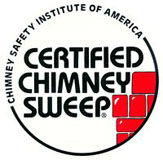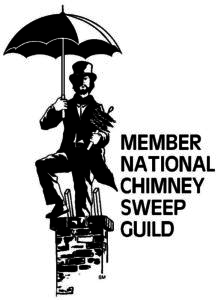With fall in full swing, days getting shorter, and temperatures dropping, many homeowners are scrambling to have their chimney’s swept before winter arrives. However, it can be difficult to tell the good from the bad when it comes to chimney sweeps. Instead of price shopping or hiring the first person that comes to your door, make sure to trust your chimney system to a certified professional this year.
Are all chimney sweeps certified?

The mark of a CSIA certified chimney technician
The fireplace industry was unregulated for many years; this allowed anyone with a few brushes to call themselves a chimney sweep. Unfortunately, many of these “professionals” were untrained, seasonal workers who did nothing more than move soot and ash around and leave behind dirty fireboxes and floors.
For more than 30 years, the Chimney Safety Institute of America, or CSIA, has worked to regulate the fireplace industry by certifying chimney sweeps. Their education and training to industry professionals helps to prevent chimney fires and increase public awareness of safety issues surrounding fireplaces and chimneys.
Why hire a CSIA certified chimney sweep
The CSIA certification is the gold standard of education and training in the fireplace industry. CSIA certified sweeps have undergone years of rigorous education and testing on subjects including:
– Safety practices
– Fireplace and chimney building dynamics
– Local and national fire and building codes
– Maintenance and installation of gas heating appliances
– Current EPA emissions standards
In order to maintain their CSIA certifications, sweeps must complete continuing education courses and retest every three years. This ensures that CSIA certified sweeps are always up to date on the latest advancements in the fireplace industry.
Finding the right chimney sweep
While homeowners should do their research before hiring a chimney sweep, price shopping will find you savings – but rarely the best chimney services. Instead, look for a company with CSIA certified chimney sweeps, several years of experience, and a good professional reputation. The following are some examples of questions to ask before hiring a chimney sweep.
– How long have you been in business in this area?
– Do you have references available from current customers?
– Does the company or individual chimney sweep carry liability insurance?
– What is your rating with the Better Business Bureau? Are there any complaints filed against you currently?
– Will the chimney sweep who works at my home be CSIA certified?
Working with a professional chimney sweep makes a difference!
Chimney sweeps have come a long way since the days of Bert and the singing sweeps from Mary Poppins! Modern chimney sweeps are educated, certified, and trained professionals who can do much more than simply clean your flue.
Jack Pixley Sweeps are proud that all of our sweeps are CSIA certified; this gives our customers confidence knowing they are working with knowledgeable, reliable professionals. For more information on the importance of working with a certified chimney sweep or to schedule your next appointment, contact Jack Pixley Sweeps today!
The chimney and fireplace industry is still widely unregulated, especially when compared to other professional groups. Because of this, almost anyone with a truck and brushes can call themselves a chimney sweep. One of the most effective ways to tell professional chimney sweeps is their membership in professional organizations and guilds. At Jack Pixley Sweeps, we are proud to have certified sweeps. We are also proud of our memberships in a variety of professional groups including the National Chimney Sweep Guild (NCSG).
What is the NCSG?
 The National Chimney Sweep Guild is a professional guild for chimney sweeps dedicated to improving fireplace safety, educating consumers, and encouraging professionalism among chimney sweeps. Founded in 1977, NCSG is dedicated to its mission of “inspiring innovation, professionalism and community among chimney sweeps and venting professionals through advocacy, industry leading conferences and journalism, covering people, tools, health, standards, and education for a successful business and the safety of the American people.”
The National Chimney Sweep Guild is a professional guild for chimney sweeps dedicated to improving fireplace safety, educating consumers, and encouraging professionalism among chimney sweeps. Founded in 1977, NCSG is dedicated to its mission of “inspiring innovation, professionalism and community among chimney sweeps and venting professionals through advocacy, industry leading conferences and journalism, covering people, tools, health, standards, and education for a successful business and the safety of the American people.”
What does the NCSG do?
The NCSG aims to increase professional standards for chimney sweeps throughout the country. Through education, members can take part in up-to-date training to keep informed on safety standards in the fireplace industry. The NCSG also holds an annual conference that allows chimney professionals to network, connect, and learn from respected industry professionals. They even go beyond the surface by providing its members with a Code of Ethics to guide their business.
The most important parts of NCSG membership is the Code of Ethics. It is designed to hold chimney sweeps to a higher standard of performance and professional behavior. Homeowners can put their full trust in members of the NCSG. Our members are trustworthy and trained professionals, who really care about fireplace and chimney with the utmost professionalism and care.
Choose a professional chimney sweep!
At Jack Pixley Sweeps, we are proud to be professional, full-time chimney sweeps. In addition to our membership in the National Chimney Sweep Guild, our sweeps are members of other professional organizations including the Builders Association of Minnesota, the Brick Industry Association, and our sweeps are all Chimney Safety Institute of America (CSIA) certified.
Since 1977, we have been providing our friends in the greater Minneapolis area with comprehensive chimney and fireplace care. With more than 100,000 satisfied customers, we are ready to handle everything from annual sweepings to major fireplace rebuilds! Trust the professionals at Jack Pixley Sweeps to care for your heating appliance. Contact us today for more information on how we strive to be “The name you can trust!”
Fireplaces continue to be beautiful additions to many homes. Additionally, many homeowners find that they rely on them in winter to add warmth and comfort to their homes.
Despite their popularity and widespread use, most people do not understand how their chimneys work. This can sometimes lead to homeowners misidentifying the cause of an issue or not realizing it is time for maintenance.
The following are some of the most important components of your chimney that many people are unfamiliar with. Learning more about the anatomy of your chimney can help you identify and understand any chimney issues you may have in the future.

Chimney cap
The chimney cap covers the top entrance of your flue, allowing smoke to safely exit while preventing water, animals, and debris from getting in. Uncapped chimneys or those with damaged caps are more likely to have issues with water damage, blockages, or animals nesting in the chimney.
Chimney crown
A chimney crown is a slab, typically made of concrete, which protects the masonry of your chimney. Damaged chimney crowns may allow water into the chimney structure or allow the masonry of the chimney to receive water damage.
Chimney chase cover
Similar to a chimney crown, a chimney chase cover protects the top of the chimney. Typically made of metal, chase covers were used regularly in the 1970s and 1980s with factory built or prefabricated chimneys. Over time, chimney chase covers may deteriorate, causing rust stains on the masonry of the chimney.
Chimney damper
The chimney damper separates the firebox from the flue. Open and closed using a pulley or a lever, the damper prevents heated or air conditioned air from escaping as well as minimizing drafts. Likewise, dampers help prevent moisture, debris, or animals from getting into the firebox. While dampers should be closed when the fireplace is not in use, the damper should always be opened before starting a fire to prevent smoke from backing up into a room.
Chimney flue
The chimney flue is the chamber through which smoke, gas, and other byproducts of combustion are vented to the outside.
Chimney flue lining
Chimney flue liners protect the surrounding building materials from the hot air, smoke, gas, and other byproducts of combustion that are travelling up the flue. There are three main types of flue linings: clay tiles, metal, or cast in place. Over time, creosote can build up on the flue lining. This byproduct of combustion is highly flammable, and it’s removal is the primary purpose of annual chimney sweepings.
Smoke chamber
The smoke chamber is designed to help compress smoke from the firebox into the flue without creating a backdraft. Smoke chambers are created with a sloping wall just above the firebox. A well designed smoke chamber with allow smoke, gas, and other byproducts of combustion to smoothly and quickly travel up the flue.
Smoke shelf
Located behind the damper, the smoke shelf is designed to catch any water or debris that enters the chimney. The smoke shelf also helps compress the large amounts of smoke created in the firebox to the much smaller entrance to the flue.
Chimneys are complex structures with a number of working parts that must be kept up in order to keep your fireplace working well. Contact the experts at Jack Pixley Sweeps today to schedule a sweeping and inspection to ensure your fireplace and chimney are in prime condition.


 The
The 